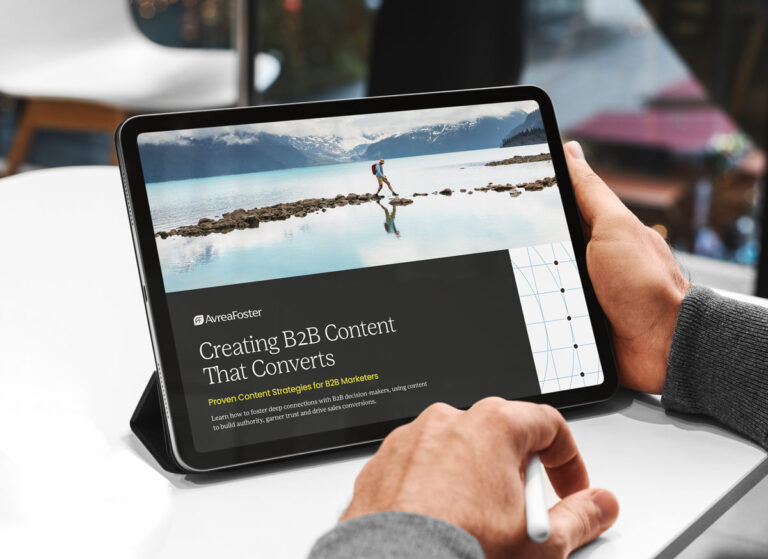In this episode, Dave and Jon sit down with Libby Graham, AvreaFoster’s Senior Brand Strategist, to explore the growing role of AI in the brand discovery process — from assisting in research and speeding up ideation. In the process, they touch on AvreaFoster’s larger philosophy around generative AI, the key components of a successful brand discovery process, and some additional considerations that can help to mitigate risk when leveraging AI during brand discovery. Topics include:
- Establishing AI governance. Understand the importance of formalizing the ground rules of generative AI usage and the implementation of human-in-the-loop systems.
- Tactic use cases for AI in brand discovery. Learn all about using AI as your “super librarian” to accelerate research and uncover insight at a faster pace than otherwise possible.
- The three components of brand discovery. Dig into audience analysis, peer landscape analysis and brand analysis, as well as how generative AI can make an impact on each component.
- The “trust but verify” mindset. How to approach AI-generative research with the proper amount of skepticism to ensure you and your clients are protected.
READ THE TRANSCRIPT
Libby Graham: 00:01
Our core philosophy is that AI is a research accelerator, but human insight is the strategic compass.
Announcer: 00:10
Welcome to the podcast B2B Insights. Our take on a podcast series where we dive in and discuss all things B2B marketing. B2B Insights is brought to you by AvreaFoster, one of the most respected brand and digital marketing agencies in the Southwest. At AvreaFoster, we build authentic relationships so brands can grow and prosper. Learn more at avreafoster.com.
Jon Cannon: 00:35
Welcome to AvreaFoster’s B2B Insights. I’m Jon Cannon. Today’s discussion is packed with value whether you’re in the c suite or have a seat at the branding and marketing table. It’s a conversation about innovation between AvreaFoster’s cofounder and CEO Dave Foster and our senior brand strategist Libby Graham.
Jon Cannon: 00:51
They’re here to dive into something that could save your company thousands of dollars and months of effort, brand discovery.
Jon Cannon: 00:57
The critical foundational work that some businesses skip in their rush to create differentiating brand materials. They’ll explore how AI is transforming the discovery process, making it faster, deeper, and more actionable than ever. With that said, I’ll turn it over to Dave and our resident brand expert, Libby.
Dave Foster: 01:12
Thank you so much, Jon. And Libby, welcome to the show.
Libby Graham: 01:17
Glad to be here.
Dave Foster: 01:18
So today, we’re talking a lot about AI, and we’re talking about obviously how that informs not only our strategy, but kind of our workflows and some of the things that we do in the agency. It kind of feels like AI is the term that’s thrown around all over the place. It’s been going for years now. And a lot of our clients and really every business is in the process of figuring out how AI is going to impact their business, what’s their strategy, where they’re investing, where they’re optimizing, and we’re right in that game too, right?
Libby Graham: 01:52
Yep. AI is absolutely on the tip of everyone’s tongue. I mean, own clients have adopted AI in their operations. Some of our clients have built their entire business on AI, you know, like AI based platforms, game changing technology solutions. Our clients are really progressive.
Libby Graham: 02:15
So they want a branded marketing partner with an equally progressive approach to AI?
Dave Foster: 02:21
You’re right Libby. Our clients are obviously inquiring how we’re using AI and we’re using it in multiple facets of our business. Whether that be AI embedded in the tools that we already have, what is our strategy around AI, How do we provide offerings to our clients using AI? How do we become more productive? Lot of different marketing automation, you name it.
Dave Foster: 02:45
We’re doing it in a lot of different ways. So relative to brand discovery, what are business leaders asking relative to AI?
Libby Graham: 02:52
Well, most clients want to know first what our approach to AI is. Really what they’re asking is what our what’s our philosophy. At this point most businesses and not just b to b, but especially b to g, business to government, they have gone through the painstaking process to establish an AI governance, document policies, have an overall approach in how they’re going to be using AI and where they will draw the line, so to speak. And so doing that does demand that they select partners with similar philosophies.
Dave Foster: 03:33
Okay. So what’s your response when they ask you about that approach?
Libby Graham: 03:37
Well, as it relates to brand discovery, which is what we’re talking about today, our core philosophy is that AI is a research accelerator, but human insight is the strategic compass.
Dave Foster: 03:51
So why not analysis? Why not just ask AI to interpret and strategize based on those insights that it’s uncovered?
Libby Graham: 03:58
Well, in short, AI is a model of language, not a model of thinking regardless of what some people will tell you. It’s using a method of probability that plays out like a fill in the blank game. So it can answer what comes next given x, y, z information. And by definition, it will come out with average answers. There is a predictive analytics function, but it really can’t be trusted to predict what your competitors are going to do, how your audience will react, which solutions should be sunset versus built or bought.
Libby Graham: 04:35
That’s where human experience comes into play. I actually heard several weeks ago a lawyer talking about using AI in casework. And of course, this is, you know, a completely different industry. But it was interesting because he was talking about, like, here’s what AI can do for us. Like, it can pull all these cases to, you know, say, hey, here’s something similar to what you’re going through.
Libby Graham: 05:00
And he named a bunch of stuff. And then he said, but AI can’t tell you what the judge had for breakfast. And I think about that all the time. I’m like, yeah, because there all these variables in the world and AI is just not a human that’s gonna go, but what if? So that’s what I mean when we’re talking about real interpretation and creative analysis and recommendations, you have to be a human thinking machine.
Dave Foster: 05:24
Libby, that’s a good analogy. I mean, that makes perfect sense. So, know, really if there are all these elements of analysis that brand strategists are still having to do, just kind of how does AI help in the research process?
Libby Graham: 05:38
In brand research, AI is like a super librarian. It’s working at hyper speed, building really insightful reports and readouts. So a tremendous time saver. And in branding and marketing, as in everything, time is money.
Dave Foster: 05:56
Indeed, on that, as we’ve known that for our whole career. Maybe speak to us to the work involved in brand research before we get into AI’s supportive role.
Libby Graham: 06:11
Oh, yeah, sure. So there are, I guess, really three components to brand discovery. I mean, really there are a lot more, but just for the sake of this brief conversation, I’m going to narrow it down to three. There’s audience analysis, peer landscape analysis, and then, of course, the analysis of our clients’ brands. So audience analysis meaning getting qualitative and quantitative insights from the most valuable players, so whatever the stakeholders are.
Libby Graham: 06:40
They could be the potential buyers, prospects, the current customers, retention is important, employees, shareholders, partners, what have you. The pure landscape analysis, of course, we’re looking at competitors. We’re looking for recurring themes, possible white space where our client can authentically stand out. And then of course, we’re auditing all the client’s current brand materials, how they are positioned in market currently. From a business strategy standpoint, overlaying that and thinking about where they want to be positioned in the future.
Libby Graham: 07:19
The idea is really to overlap these three elements, kind of like a Venn diagram, to reveal a map of evidence that defines the brand strategy and aligns that with the business strategy. So we answer questions like, how do we stand out in the market? What can we truly claim that others can easily replicate? How do we take advantage of market trends or head off threats to the business? How do we appeal to decision makers?
Libby Graham: 07:50
What will give us more credibility? And certainly, of course, where do we need to be to reach those decision makers? I mean obviously it all depends on the engagement, all of our client engagements are a little bit different.
Dave Foster: 08:04
Right, yeah that makes perfect sense and you know whether it’s an M and A based engagement that we have or we’re doing an integration strategy for the client or even brand architecture, a brand refresh versus a whole new brand launch for the client. So let’s talk a little bit about AI’s role in supporting the research.
Libby Graham: 08:26
We most often use the deep research functionality in AI. Claude has that, ChatGPT and even Gemini. We can upload files and ask for summaries as well as inquiries related to those summaries. For example, to meet our qualitative research needs, we conduct interviews with key stakeholders, whether they’re internal or external. I can load those meeting notes or even the recordings into AI and have the tool analyze the responses to offer things like sentiment around vision, mission, and values, sales challenges, just the most frequently mentioned competitors, and then of course what the challenges are related to those competitors.
Libby Graham: 09:14
We can also turn those insights into quant based analysis like how many stakeholders were aware of ABC brand, what percentage of customers were satisfied or dissatisfied? So we’re bridging to the propensity to leave the brand. This is something that we previously took days to do. And now they’re really done in minutes. We can also ask AI to analyze websites.
Libby Graham: 09:42
So focusing on messaging themes found across the peer landscape. Again, that’s when we’re getting into the white space. Also something that would previously take us days and was very manual.
Dave Foster: 09:54
So would you say that really AI is mostly a catalyst?
Libby Graham: 09:57
That’s a big part of it, yes. But we’re seeing more value in new ways. For example, AI is getting really good at putting together buyer personas and customer journey maps. Based on research it’s done and or rather that it’s been fed, AI can identify decision makers, influencers, and end users, you know, kind of segment those and understand their pain points, what their priorities are, their success metrics. It can also map the typical customer journey, what’s going through their mind at the awareness, the consideration, and decision stages, and then what information is needed at each of those stages.
Libby Graham: 10:42
Now, I would be remiss not to mention again, that we have a trust but verify mindset throughout all of this.
Dave Foster: 10:50
Yeah, you’re right. And we talk a lot about it starts with a human and ends with a human, right? Yep. I mean, it’s always how we prompt, how we engineer what we’re trying to get out of AI. But then we’re always on the backside of it making sure that it’s accurate and that it’s actually usable in market because we have a lot of concerns for our clients obviously around trust and trademark and copyright and all those kind of things.
Dave Foster: 11:18
And funny enough, we’ve obviously heard about all the hallucinations that make it to the public, right? That’s what an embarrassment.
Libby Graham: 11:25
Yeah, we owe it to our clients to apply our experience and expertise to every aspect of the engagement. That is what they are paying for. Regardless of the make or model, AI is prone to those embarrassing hallucinations, incorrect information, fabricated stories. We’ve all seen those headlines. There are ways to reduce risk of hallucinations.
Libby Graham: 11:53
Quality prompts, interrogation, and active involvement. So quality prompts, like our experience with brand strategy gives us a leg up in informed retrieval, if you will. But also our experience using AI for deep research has allowed us to sharpen this process. Related, I referenced earlier uploading materials that have already been verified and inputting the actual URLs. We want the AI to scrape.
Libby Graham: 12:24
That significantly reduces the risk of AI confusing the brand name for another business, another website, or social channel. So we are guiding where AI looks. As far as interrogation goes, obviously validate by running the same prompts through different LLMs, checking the sources, that is all very critical. And then finally, related to that active involvement, it’s really important to remember as an agency partner we are actively involved from the very beginning. We are hosting leadership meetings, one on one interviews, we’re doing workshops, we’ve done a surface level audit of the brand materials and the own digital media before we even win the business.
Libby Graham: 13:12
So when we get AI summaries of our own, for instance, those interview notes, the recurring themes and messaging and the market, we know if the AI has gone off the rails.
Dave Foster: 13:24
And that’s why we have to have protocols
Jon Cannon: 13:29
Dave, Libby, this conversation has been very informative. The ways that we’re using AI now are certainly compelling, and I’m very excited to see how we’re gonna use it in the future. Libby, is there anything else you wanna leave our listeners with before we close?
Libby Graham: 13:38
Well, yeah. I mean, I know we have a range of listeners. So I’ll say to the brand and marketing AI users listening right now, especially in the beginning stages of using AI, be patient. When AI gives you a ridiculous answer, it’s really difficult not to react like AI is a lazy store clerk, and you want to just roll your eyes and declare like, this has no value. But I think what AI is really asking us to be as a teacher, to state in response to the ridiculous answer that this answer was unsatisfactory for these reasons and try again focusing on x, y, z or whatever it is.
Libby Graham: 14:21
So honing your prompts, your style of communication is really critical and it doesn’t happen overnight. Also, I have to say that there are so many business leaders telling their people to quote unquote go learn AI. And that is really overwhelming if you don’t if you haven’t even begun. I myself have been trying to absorb a lot of AI experts. And you’re just pulled in a million different directions.
Libby Graham: 14:49
And it gets really woolly really fast. So I have found it really helpful to remember that we are all on like team F1, Formula One. This is like as close to sporting as I get. So I’m just going to use Formula One as my example. So like drivers don’t know how to build a race car engine.
Libby Graham: 15:08
They don’t need to. Different roles around AI are speaking in very different terms and value propositions. I’m a driver. I just need to understand how to drive AI. I don’t need to know how to fix it or build it.
Libby Graham: 15:23
Just continue to drive it better and better. And then I’ll just say to the business leaders listening, everyone is touting their use of AI. And it’s great to have a POV, but business leaders really need to be asking their potential partners for AI use cases, especially if they’re charged with positioning their brand and delivering ROI in sales and marketing. Everyone has an opinion about AI. That’s not hard.
Libby Graham: 15:51
We need to get tactical and ask, like, what’s your experience with it? Tell me how. That really needs to be the conversation that we’re having today.
Announcer: 16:01
This has been B2B Insights. Find all our news and sign up to receive our e-newsletter at avreafoster.com/contact. B2B Insights is provided by AvreaFoster. Copyright 2025 AvreaFoster Inc. All rights reserved.
Announcer: 16:17
Digital redistribution to the public is permitted only with express written permission from AvreaFoster Inc. Visit avreafoster.com for more information.
Dig Deeper into B2B Marketing Insights?
* Required field



